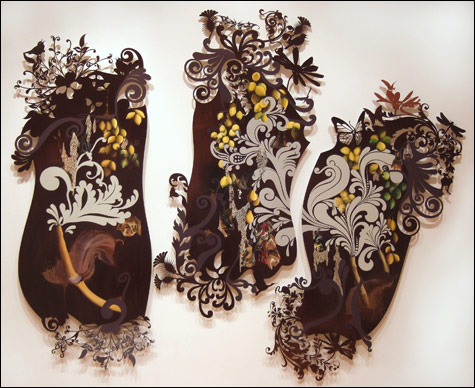
LEMON SPRAY: Resa Blatman’s subject has become the biological imperative of beauty. |
“Sixth Annual Juried Summer Exhibition” | Tufts University Art Gallery, 40R Talbot Ave, Medford | Through August 2 “Salt of the Earth” | Montserrat College of Art, 23 Essex St, Beverly | Through July 24 |
Tufts University Art Gallery's "Sixth Annual Juried Summer Exhibition" is one of those summer sampler shows that's got about a million people in it. But a generous spirit suits this hyper-local survey, making it seem like a big community get-together. Gallery director Amy Ingrid Schlegel and her staff selected 37 artists from Medford, Somerville, and Grafton (Tufts's host communities). It's a mixed bag — how could something so populous not be? — of traditional media and photography. New media and conceptual art, which often dominate Boston's art discourse, are absent.The payoff is the inclusion of two Somerville artists who have made breakthroughs in the past couple of years: Resa Blatman and Raúl González (who is a friend of mine). Both are ripe for major one-person shows — like, say, an ICA "Momentum" exhibit.
Blatman had been making paintings of flowers, birds, and arabesque patterns for a while, but the compositions felt awkward, flat. The realist flora and fauna seemed too separate from the decoration. I wonder whether she was just holding back. Last year, something clicked and her paintings became sharper, lusher. Suddenly they were over the top — in a ravishing way.
You can probably date the change to last July, when she began painting on PVC panels with her decorative Art Nouveau–style patterns jigsawed out of the edges. (She designs the patterns on a computer, then has them sliced by a laser-cutting shop.) This wove the decoration through the entire composition, activating the space in and around the paintings. And the patterns grew bigger, more dynamic, and more sexual. A mushroom ejaculating an arabesque is not just a mushroom. A subject came into focus: the biological imperative of beauty. In other words: beauty for sex's sake.
Blatman debuted these works in "Overflow," a group show she organized at South Boston's Laconia Gallery last fall. Her two paintings here are even better. They continue her mix of realist critters (bats, mice, butterflies, dragonflies) and floral patterns, but in increasingly asymmetrical compositions that are more animated, more surprising, more seductive.
González's breakout show was "Chingasos" at East Boston's New England Gallery of Latin American Art last spring. He's a member of the Miracle 5 collective, and his previous work riffed goofily on superheroes and monetary currency, but it felt corny and stunted in the way that superhero stuff often is. His jam-packed East Boston show played on boxing and his Mexican-American ancestry. He created the story of a boxer as a way of showing how people reinvent themselves when they come to the United States. The subject gave his art more emotional heft and focused his skills, with the energy of the early work now poured into a folksy blend of bright cartoons and street graphics. His four pieces here build on that breakthrough; they're even more substantial and assured.
After his immigration fantasy, he tells me, "I started thinking of people who were already here and had labels put on them." A year ago, he began to do drawing-paintings with buffaloes and cartoon Indians inspired by the Indian caricatures in Disney's 1953 animation Peter Pan and touching on their casual racism. The series rounds up his concerns (the Americas, race, pop culture, insiders, outsiders) in an epic subject that finally seems suited to the scale of his ambition.

MYTHMAKING: Raúl González’s recent work finally seems suited to the scale of his ambition. |
One of the four drawing-paintings here has six cartoon Indian heads where a buffalo's face would be. Another shows the head of a buffalo that's wearing a crown of thorns, dripping blood, and breathing out a cartoon cloud. González will stain his paper with tea or coffee, then go to work with pencil, spray paint, gouache, acrylic, and crayons. The staining plus his preference for autumn brown, orange, red, and ocher gives the art an aged look. He mixes the fine penwork of 19th-century illustration with the wide, flowing outlines of 20th-century cartoons. In that buffalo head, note how sensitively, how tenderly, he draws the fur and the sad, defiant eyes.
Other artists to seek out at Tufts include Marilyn Ranker, who fashions sturdy wood-and-rope abstractions with a maritime vibe, and Catalina Viejo López de Roda, who makes bright abstractions from little paper rectangles collaged on lined paper, like cute letters by Agnes Martin. Judith G. Klausner's sculpture Triumph is a lightbulb with a moth inside, as if it had finally reached its goal. Xiaowei Chen makes intense, dense, surreal pen drawings like Witness, a tour de force panorama of brains, mountains, waterfalls, and clouds. The brand of goth Klausner and Chen espouse feels somewhat generic, but there's promise here. Jeffrey Ellse impresses with his super-realist painting Basement in Medford, which comes complete with washer, drier, unused stereo speakers, and air conditioner in a dim gray room. He has chops, but he could use some of the looseness and the flow of Old Master painting.